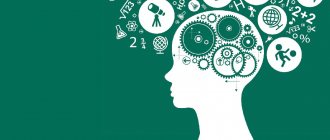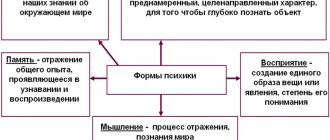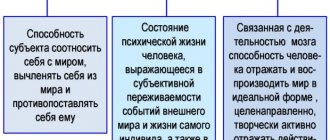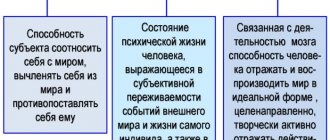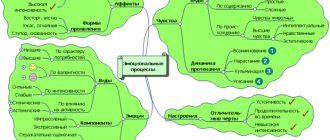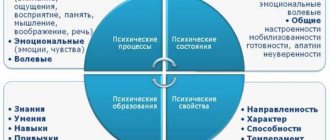Content
- Mental processes
- Mental properties
- Mental conditions
This section is studied from the 1st year of the Faculty of Psychology, since the knowledge acquired in this subject is the basis for studying further material in all sections of psychology. The results of research in the field of general psychology are also the basis for the development of all branches and sections of psychological science.
General psychology studies cognitive processes, patterns and properties of the psyche, manifestations of various mental phenomena, various theories and concepts of outstanding psychologists, and forms concepts and terms.
The subject of general psychology is mental phenomena, i.e. mental processes, mental properties, mental states.
Mental phenomena are a general psychological category that includes various manifestations of the psyche that are closely interrelated and interdependent.
Activities and mental processes
Activities in trade
1. Activity and mental processes.
ü Mental processes as internal components of activity. The dependence of the development of human mental processes on his activities. Identity of the structure of external (practical) and internal (mental) activity.
ü Participation of activity in the processes of sensation and perception.
ü Activity and attention. Active, activity-based nature of ideas.
ü Participation of activities in the formation and development of human memory.
ü Activity and intellectual processes. The dependence of speech on the nature of human activity.
2. Knowledge, abilities, skills and habits.
ü Skills and abilities as structural elements of activity.
ü Education of skills and abilities. Motor skills and abilities.
ü Cognitive skills: perceptual, mnemonic, intellectual, indicative.
ü Practical skills and abilities.
ü The concept of habit and its place in the structure of activity.
Activities and mental processes
Mental processes: perception, attention, imagination, memory, thinking, speech - act as the most important components of any human activity. In order to satisfy his needs, communicate, play, study and work, a person must perceive the world, pay attention to certain moments or components of activity, imagine what he needs to do, remember, think, and make judgments. Consequently, without the participation of mental processes, human activity is impossible; they act as its integral internal moments.
But it turns out that mental processes do not just participate in activity, they develop in it and themselves represent special types of activity.
Perception in the process of practical activity acquires its most important human qualities. In activity, its main types are formed: perception of depth, direction and speed of movement, time and space. The child’s practical manipulation with three-dimensional, nearby and distant objects reveals to him the fact that objects and space have certain dimensions: width, height, depth. As a result, a person learns to perceive and evaluate forms. Tracking movements of the hand and eye, accompanied by synergistic, coordinated contractions of certain muscle groups, contribute to the formation of the perception of movement and its direction. Changes in the speed of moving objects are automatically reproduced in the acceleration and deceleration of contractions of certain muscle groups, and this trains the senses to perceive speed.
Imagination is also connected with activity. Firstly, a person is not able to imagine or imagine something that has never appeared in experience, was not an element, subject, condition or moment of any activity. The texture of imagination is a reflection, although not literal, of the experience of practical activity,
This applies to an even greater extent to memory , and to its two main processes simultaneously: memorization and reproduction. Memorization is carried out in activity, and itself represents a special kind of mnemonic activity, which contains actions and operations aimed at preparing the material for better memorization. This is structuring, comprehension, associating material with known facts, including various objects and movements in the memorization process, etc.
Recall also involves performing certain actions aimed at promptly and accurately recalling the material imprinted in memory. It is known that consciously reproducing an activity during which some material was memorized makes it easier to recall.
Thinking in a number of its forms is identical to practical activity (the so-called “manual” or practical thinking). In more developed forms - figurative and logical - the activity moment appears in it in the form of internal, mental actions and operations.
Speech is also a special kind of activity, so the phrase “speech activity” is often used to characterize it. Since a person’s internal mental processes display the same structure as external actions, there is every reason to talk not only about external, but also internal action.
It has been experimentally proven that internal
, i.e. mental processes, called higher mental functions, are activities in origin and structure. Theories have been developed and proven in practice that claim that mental processes can be formed through external activity organized according to special rules. External activity, as a result of its special transformations aimed at reducing and automating individual links, their transformation into skills, gradually turns into internal, actually mental (interiorization). Such internalized mental processes are voluntary and speech-mediated cognitive processes: perception, attention, imagination, memory and thinking.
On the other hand, none of the mentioned mental processes proceeds as purely internal and necessarily includes some external
, usually motor units. Visual perception, for example, is inextricably linked with eye movements, touch - with. hand movements, attention - with muscle contractions that determine his concentration, switchability and absent-mindedness. When a person solves problems, his articulatory apparatus almost always works; speech activity without movements of the larynx and facial muscles is impossible. Consequently, any activity is a combination of internal and external, mental and behavioral actions and operations.
Mental properties
Mental properties are the most stable and constantly manifested personality traits, providing a certain level of behavior and activity typical for it. These are mental phenomena that are realized in a certain society.
Mental properties include:
- Temperament;
- Character;
- Capabilities;
- Directionality.
When talking about the mental properties of a personality, we are talking about its essential, more or less stable, permanent features. These are the characteristics that distinguish each person. Their totality determines a person’s individuality, because it is impossible to meet 2 people with exactly the same mental properties.
You should not confuse some isolated cases of manifestation of any traits with mental properties. After all, each of us has happened to forget something, but “forgetfulness” is not a characteristic feature for everyone. Everyone has been in an irritable state at some point, but “irritability” is characteristic only of some. Thus, a mental property can only be a stable and permanent feature of a person, which is developed and formed during life.
Psychological characteristics of activity
The activity has the following features unique to it:
- Subject : each activity has its own subject. The object of activity appears in two ways: primarily - in its independent existence, as subordinating and transforming the activity of the subject, secondly - as an image of the object, a product of the mental reflection of its properties, which is carried out as a result of the activity of the subject and cannot be realized otherwise.
- Awareness and purposefulness . Activity is regulated not by human needs, but by a perceived goal as an ideal image of a future result. The goal is a system-forming factor of activity, i.e., the main criterion for determining its content, structure and dynamics. This is the most important difference between activity and other forms of human activity.
- Social conditioning . For all its originality, human activity is a system included in the system of social relations. Outside of these relationships, human activity does not exist. A person finds in society not just external conditions to which he must adapt his activities - social conditions themselves carry within themselves the motives and goals of his activities, its means and methods. In essence, society produces the activities of the individuals who form it.
- Systematicity . Activity appears not as a simple sum of its components, but as their organized integrity. It is important to note that activity as an integrity has properties that neither its individual components nor their simple sum have.
Activities
Human activity is not only extremely complex in content and structure, but also extremely diverse in its general varieties and specific manifestations. It is traditionally accepted that the main division of activity into its types is differentiation into work, educational and play activities:
- Labor activity is the process of actively changing objects of nature, the material and spiritual life of society in order to satisfy human needs and create various values. Labor activity presupposes the receipt of some socially significant product, result, in contrast to educational and gaming activities, where this result is not socially, but individually significant and consists in the subject’s mastering of socially developed experience, knowledge, etc. for subsequent work activities.
- Teaching acts as a type of activity, the purpose of which is to acquire knowledge, skills and abilities by a person. Teaching can be organized and carried out in special educational institutions. It may not be organized and occur along the way, in other activities as a by-product, additional result. In adults, learning can take on the character of self-education. The peculiarities of educational activity are that it directly serves as a means of psychological development of the individual.
- A game is a special type of activity in which typical ways of action and interaction of people have been historically established. The result of gaming activity is not the production of any material or ideal product. However, games are of great importance in people's lives. The inclusion of a child in play activities provides the opportunity to master the social experience accumulated by humanity, as well as the cognitive, personal and moral development of the child. Of particular importance is role-playing play, during which the child takes on the roles of adults and acts with objects in accordance with the assigned meanings. The mechanism of learning social roles through role-playing games provides the opportunity for socialization of the individual. A specific feature of gaming activity is that its main motive is the process of activity itself, and not its result.
These types of activities have different significance for human development at different stages of ontogenesis. The activity, the implementation of which determines the emergence and formation of the main psychological new formations of a person at a certain stage of ontogenetic development, is called leading activity .

